This is the KOB TV Eyewitness News team after being awarded the New Mexico Broadcasters Association’s Station of the Year award at a recent banquette.
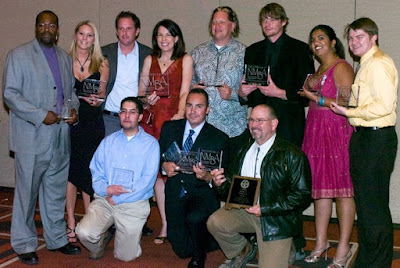 Top row: KOB’s News Chief Photographer Bazz McClain, Bess Ellenson, Zack Pearl, KOB-TV News Director Rhonda Aubrey, Joseph Lynch, Jeremy Fine, Tejal Patel and Phill Robb.
Top row: KOB’s News Chief Photographer Bazz McClain, Bess Ellenson, Zack Pearl, KOB-TV News Director Rhonda Aubrey, Joseph Lynch, Jeremy Fine, Tejal Patel and Phill Robb.Bottom row: Kenny Vigil, Jeremy JoJola, and Rick Foley.
 I don’t normally comment on crime stories.
I don’t normally comment on crime stories.
I’ve viewed the KOB TV tape of their cameraman and the Albuquerque Police Officers at the perimeter of a crime scene.
I have been asked to comment. I will not, at this time analyze all the facts of the case. KOB and the Journal seem to have that covered by posting the video and seeking comment from department officials and posting the one officer’s supplemental report.
“This was a hot scene,” APD Public Information Officer John Walsh said in an interview. It started as a traffic stop in the area of Charleston and Dallas along Central Avenue, and involved an exchange of gunfire. The assailant fled on foot from south of Central and was eventually shot several times by officers near a dumpster just north of the Caravan East nightclub building, Walsh said.
Timothy Walker, 18 was arrested, transported to the Hospital, where he was treated and released into custody. He was charged on an outstanding warrant from a grand jury indictment for: murder, conspiracy aggravated battery with a deadly weapon, and aggravated battery resulting in great bodily harm. Walker is still being held on the Thursday morning, May 27, incident, additionally charged with: two counts of attempted murder, two counts of aggravated assault on a police officer, and evading police officers. Journal time-line. Walker is also being held on a warrant from Juvenile Court on an unknown charge according to the Bernalillo County Metropolitan Detention Center’s website.
There were two passengers in the stopped vehicle, who also ran from the scene, according to Walsh. The incident involving the KOB videographer, Rick Foley, and Officer Daniel Guzman, took place at Grove and Copper, two blocks north of where the driver was arrested. The scene had not been secured, as the two passengers were still loose.
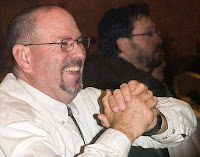 Foley, left, during a lighter moment at the NMBA awards dinner, is a 26-year veteran KOB employee.
Foley, left, during a lighter moment at the NMBA awards dinner, is a 26-year veteran KOB employee.
Guzman joined APD on April 14, 2007 and graduated the Police Academy in October, according to Walsh. He transferred from Albuquerque Public Schools Police where he was certified through the State's Police Academy. He attended the APD academy before working the streets.
The case is being sent to Independent Review Officer William Deaton for investigation, Walsh said.
 There is a lot of fodder, but I am going to refrain and let the internal system work. I too will be watching with great anticipation for how this works out.
There is a lot of fodder, but I am going to refrain and let the internal system work. I too will be watching with great anticipation for how this works out.
I will however, add to elevating the public discussion by offering a few facts. The Standard Operating Procedure of the Albuquerque Police Department pertaining to:
Furnishing officer’s name and badge number:
Police Press Relations; and
Dealing with onlookers at incidents and crime scenes, including the press.
This information was found online. Though dated, it was valid as of 2006. Walsh was unable to confirm the currency of the SOP, because he was away from his office. These are not the only issues the IRO may look into, but they seem like the ones that are generating much of the discussion. An informed public opinion is better than an uninformed one.
 Daniel Guzman is the son of David Guzman who was a fellow Academy classmate of mine in 1976. I consider Dave a friend; we worked on police officer issues through the union and when he was associated with the Chicano Police Officers’ Association.
Daniel Guzman is the son of David Guzman who was a fellow Academy classmate of mine in 1976. I consider Dave a friend; we worked on police officer issues through the union and when he was associated with the Chicano Police Officers’ Association.
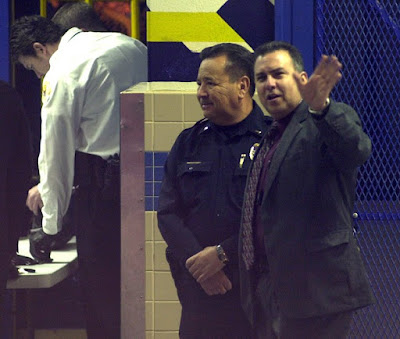 Albuquerque Public Schools Police Lt. David Guzman, left, seen here with APD's Mayoral Detail Sgt. Louie Sanchez, waving, at the Feb. 2, Hillary Clinton political rally at Highland High School, rose to the rank of Lieutenant with APD before retiring and going to work as aBosque Farms Police investigator and later was with APS Police. He was the acting Chief after Gilbert Lovato was placed on administrative leave amidst a flurry of accusations. Lovato’s contract was allowed to expire. David Guzman recently returned to APD as a retired rehire.
Albuquerque Public Schools Police Lt. David Guzman, left, seen here with APD's Mayoral Detail Sgt. Louie Sanchez, waving, at the Feb. 2, Hillary Clinton political rally at Highland High School, rose to the rank of Lieutenant with APD before retiring and going to work as aBosque Farms Police investigator and later was with APS Police. He was the acting Chief after Gilbert Lovato was placed on administrative leave amidst a flurry of accusations. Lovato’s contract was allowed to expire. David Guzman recently returned to APD as a retired rehire.
So what’s wrong with this picture?
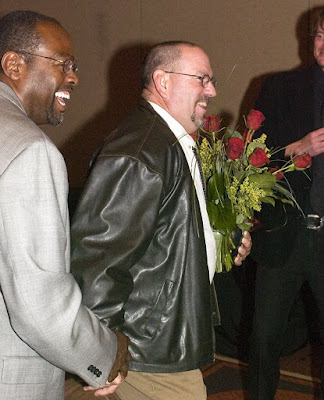 KOB Photojournalist Rick Foley, center, is seen here joking with staffers after the New Mexico Broadcaster’s Association awards dinner where KOB won station of the year. Foley was awarded the roses from the banquet table’s centerpiece as Chief Photographer Bazz McClain, left, who jokingly twisted his arm as his peers suggested McClain took on the role of “Officer Guzman” ribbing him about being detained.
KOB Photojournalist Rick Foley, center, is seen here joking with staffers after the New Mexico Broadcaster’s Association awards dinner where KOB won station of the year. Foley was awarded the roses from the banquet table’s centerpiece as Chief Photographer Bazz McClain, left, who jokingly twisted his arm as his peers suggested McClain took on the role of “Officer Guzman” ribbing him about being detained.
 It wasn’t the first encounter that APD had with KOB photojournalists in the recent past.
It wasn’t the first encounter that APD had with KOB photojournalists in the recent past.
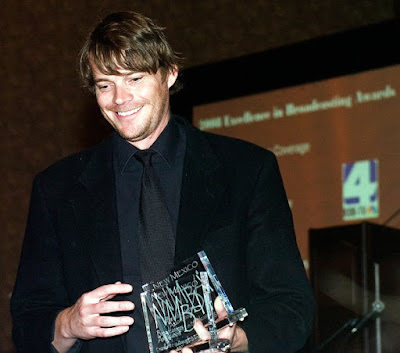 Jeremy Fine, above, accepting NMBA awards, was detained when he was singled out because he was filming a 2006 balloon crash site. He was on the public side of a police line and was physically escorted away, while citizens, the same distance away, were not moved. APD Chief Ray Schultz found the officers had acted inappropriately and ordered retraining.
Jeremy Fine, above, accepting NMBA awards, was detained when he was singled out because he was filming a 2006 balloon crash site. He was on the public side of a police line and was physically escorted away, while citizens, the same distance away, were not moved. APD Chief Ray Schultz found the officers had acted inappropriately and ordered retraining.
KOB-TV News Director Rhonda Aubrey has alluded to the possibility of bringing private criminal charges against Guzman.
No doubt that should KOB TV have to get to that point, it would generate such hate and discontent amongst street officers that the blowback would have ramifications well beyond just KOB, to all media outlets.
 Analysis
Analysis
Sir Robert Peel was England's Home Secretary and founded the London Metropolitan Police Department at Scotland Yard on September 30, 1829.
Peel developed nine principles of policing:
Not withstanding Peel's Principles, law enforcement’s ability would be greatly diminished should the cops feel under legal attack from the press in their "watchdog" role. My Take
My Take
Eleven-years ago, I observed a similar situation, though there was no violence. I wrote, The Jumper and the Power to Bounce the Press, for my personal, in-house pamphlet, The Blue Flyer, now online.
It has been nine-years since I arranged and facilitated an in-house Police-Press Street Relations training seminar for first line supervisors. We also invited 20 members of the press, who normally worked a police beat.
I wrote about the success of the Police-Press Street Relations Seminar in the union’s newsletter. Chief Ray Schultz was the Captain at the Police Academy and hosted the event. He also added to the curriculum, having just completed classes in media relations at the FBI National Academy.
 It might be time for the cops and press to get in a big room again and find out what it’s like on both side of the yellow tape.
It might be time for the cops and press to get in a big room again and find out what it’s like on both side of the yellow tape.
 I don’t normally comment on crime stories.
I don’t normally comment on crime stories.I’ve viewed the KOB TV tape of their cameraman and the Albuquerque Police Officers at the perimeter of a crime scene.
I have been asked to comment. I will not, at this time analyze all the facts of the case. KOB and the Journal seem to have that covered by posting the video and seeking comment from department officials and posting the one officer’s supplemental report.
“This was a hot scene,” APD Public Information Officer John Walsh said in an interview. It started as a traffic stop in the area of Charleston and Dallas along Central Avenue, and involved an exchange of gunfire. The assailant fled on foot from south of Central and was eventually shot several times by officers near a dumpster just north of the Caravan East nightclub building, Walsh said.
Timothy Walker, 18 was arrested, transported to the Hospital, where he was treated and released into custody. He was charged on an outstanding warrant from a grand jury indictment for: murder, conspiracy aggravated battery with a deadly weapon, and aggravated battery resulting in great bodily harm. Walker is still being held on the Thursday morning, May 27, incident, additionally charged with: two counts of attempted murder, two counts of aggravated assault on a police officer, and evading police officers. Journal time-line. Walker is also being held on a warrant from Juvenile Court on an unknown charge according to the Bernalillo County Metropolitan Detention Center’s website.
There were two passengers in the stopped vehicle, who also ran from the scene, according to Walsh. The incident involving the KOB videographer, Rick Foley, and Officer Daniel Guzman, took place at Grove and Copper, two blocks north of where the driver was arrested. The scene had not been secured, as the two passengers were still loose.
 Foley, left, during a lighter moment at the NMBA awards dinner, is a 26-year veteran KOB employee.
Foley, left, during a lighter moment at the NMBA awards dinner, is a 26-year veteran KOB employee.Guzman joined APD on April 14, 2007 and graduated the Police Academy in October, according to Walsh. He transferred from Albuquerque Public Schools Police where he was certified through the State's Police Academy. He attended the APD academy before working the streets.
The case is being sent to Independent Review Officer William Deaton for investigation, Walsh said.
 There is a lot of fodder, but I am going to refrain and let the internal system work. I too will be watching with great anticipation for how this works out.
There is a lot of fodder, but I am going to refrain and let the internal system work. I too will be watching with great anticipation for how this works out.I will however, add to elevating the public discussion by offering a few facts. The Standard Operating Procedure of the Albuquerque Police Department pertaining to:
Furnishing officer’s name and badge number:
Police Press Relations; and
Dealing with onlookers at incidents and crime scenes, including the press.
This information was found online. Though dated, it was valid as of 2006. Walsh was unable to confirm the currency of the SOP, because he was away from his office. These are not the only issues the IRO may look into, but they seem like the ones that are generating much of the discussion. An informed public opinion is better than an uninformed one.
1-03-3 FURNISHING NAME AND EMPLOYEE NUMBER TO THE PUBLICThis is without getting into the use of force issues and there are several, starting with the lack of verbal commands.
A. Officers shall cordially furnish their name and employee number to any person requesting such information when they are on duty or while acting in an official capacity except:
1. When the withholding of such information is necessary for the performance of police duties.
2. When it is authorized by proper authority.
B. Officers shall furnish APD business cards to victims and/or witnesses of crimes, unless the officer's assignment and good judgment dictates that identity should not be revealed.
1-13 POLICE PRESS RELATIONS/RELEASE OF POLICE
IDENTIFICATION PHOTOGRAPHS
POLICY:
Department policy is to support the fundamental principles of the First Amendment to the Constitution of the United States, as it pertains to the rights of the news media and the public. The police department is committed to informing the community and the news media of events within the public domain that are handled by or involve the department.
PROCEDURE:
1-13-1 DEPARTMENT/PUBLIC LIAISON
The department public information officer (PIO) is to provide an information liaison between the department and the general public. Information disseminated from this department is to be accurate, and timely. Every effort will be made to release information to the news media with impartiality.
RULES:
1-13-2 SUPERVISOR RESPONSIBILITIES
A. Initial news media contacts will be handled by the highest ranking supervisor/investigator at the scene of an incident, when possible. The highest ranking supervisor may request that the PIO handle the news media when the incident requires an immediate spokesperson.
B. The supervisor will furnish statements to the PIO and news media to inform them of factual information about the incident.
C. Supervisors will immediately notify the PIO or Assistant PIO on all newsworthy events, with a follow-up through the chain of command.
D. Routine news media information such as traffic accidents, simple assaults, batteries, statistics, or follow-up information regarding on-going cases, can be handled by command personnel, the PIO, or their designee.
E. Procedures involving pre-arranged law enforcement activities and the media/photographers:
1. A Department Ride Along Request form must be completed.
2. An APD-Media/Photographer Agreement form (PD Form 1010) must be completed.
This form explains that the reporter/photographer must acquire written consent from the victim(s), alleged perpetrator(s), or persons occupying private areas prior to allowing them onto private property or filming on private property. It is the responsibility of the reporter/photographer to obtain permission, not the officers.
3. If the reporter/photographer does not obtain consent, then the media should be prohibited from participation in law enforcement activities that occur in private areas.
1-13-3 PUBLIC INFORMATION OFFICER RESPONSIBILITIES
A. The PIO is available for information between the hours of 0600 and 2400 hours when the Assistant PIO is off duty.
1. During department PIO off-duty hours, the Assistant PIO can be contacted through Radio Control.
2. The department PIO will be available during off-duty hours on an emergency basis as determined by Radio Control.
B. The PIO is available, if requested, to handle the news media for comment, once the PIO has been thoroughly briefed by the supervisor who is/was at the scene.
C. Follow-up information will be handled by the PIO. This requires that supervisors or their designees brief and update the PIO as the incident develops. Records or Communications supervisory personnel can disseminate routine follow up information when briefed by the incident supervisor or the PIO.
1-13-4 OFFICERS AND CIVILIAN PERSONNEL DUTIES
A. Personnel will not discuss or disseminate information to the media on incidents that they have no direct knowledge of or if not directly involved in the investigation. If the incident is of a serious nature, or involves APD policy, the matter will be referred to their area/division commander or the appropriate deputy chief.
B. All civilian supervisors will refer news media contacts to their division commander.
 Daniel Guzman is the son of David Guzman who was a fellow Academy classmate of mine in 1976. I consider Dave a friend; we worked on police officer issues through the union and when he was associated with the Chicano Police Officers’ Association.
Daniel Guzman is the son of David Guzman who was a fellow Academy classmate of mine in 1976. I consider Dave a friend; we worked on police officer issues through the union and when he was associated with the Chicano Police Officers’ Association. Albuquerque Public Schools Police Lt. David Guzman, left, seen here with APD's Mayoral Detail Sgt. Louie Sanchez, waving, at the Feb. 2, Hillary Clinton political rally at Highland High School, rose to the rank of Lieutenant with APD before retiring and going to work as aBosque Farms Police investigator and later was with APS Police. He was the acting Chief after Gilbert Lovato was placed on administrative leave amidst a flurry of accusations. Lovato’s contract was allowed to expire. David Guzman recently returned to APD as a retired rehire.
Albuquerque Public Schools Police Lt. David Guzman, left, seen here with APD's Mayoral Detail Sgt. Louie Sanchez, waving, at the Feb. 2, Hillary Clinton political rally at Highland High School, rose to the rank of Lieutenant with APD before retiring and going to work as aBosque Farms Police investigator and later was with APS Police. He was the acting Chief after Gilbert Lovato was placed on administrative leave amidst a flurry of accusations. Lovato’s contract was allowed to expire. David Guzman recently returned to APD as a retired rehire.So what’s wrong with this picture?
 KOB Photojournalist Rick Foley, center, is seen here joking with staffers after the New Mexico Broadcaster’s Association awards dinner where KOB won station of the year. Foley was awarded the roses from the banquet table’s centerpiece as Chief Photographer Bazz McClain, left, who jokingly twisted his arm as his peers suggested McClain took on the role of “Officer Guzman” ribbing him about being detained.
KOB Photojournalist Rick Foley, center, is seen here joking with staffers after the New Mexico Broadcaster’s Association awards dinner where KOB won station of the year. Foley was awarded the roses from the banquet table’s centerpiece as Chief Photographer Bazz McClain, left, who jokingly twisted his arm as his peers suggested McClain took on the role of “Officer Guzman” ribbing him about being detained. It wasn’t the first encounter that APD had with KOB photojournalists in the recent past.
It wasn’t the first encounter that APD had with KOB photojournalists in the recent past. Jeremy Fine, above, accepting NMBA awards, was detained when he was singled out because he was filming a 2006 balloon crash site. He was on the public side of a police line and was physically escorted away, while citizens, the same distance away, were not moved. APD Chief Ray Schultz found the officers had acted inappropriately and ordered retraining.
Jeremy Fine, above, accepting NMBA awards, was detained when he was singled out because he was filming a 2006 balloon crash site. He was on the public side of a police line and was physically escorted away, while citizens, the same distance away, were not moved. APD Chief Ray Schultz found the officers had acted inappropriately and ordered retraining.KOB-TV News Director Rhonda Aubrey has alluded to the possibility of bringing private criminal charges against Guzman.
No doubt that should KOB TV have to get to that point, it would generate such hate and discontent amongst street officers that the blowback would have ramifications well beyond just KOB, to all media outlets.
 Analysis
AnalysisSir Robert Peel was England's Home Secretary and founded the London Metropolitan Police Department at Scotland Yard on September 30, 1829.
Peel developed nine principles of policing:
1. The basic mission for which the police exist is the prevention of crime and disorder in the interest of community welfare and existence.
2. The ability of the police to perform their duties is dependent upon public approval of police actions.
3. Police must secure the willing cooperation of the public in voluntary observance of the law to be able to secure and maintain the respect of the public.
4. The degree of cooperation of the public that can be secured diminishes proportionately to the necessity of the use of physical force.
5. Police seek and preserve public favor not by catering to public opinion but by constantly demonstrating absolute impartial service to the law.
6. Police use of physical force to the extent necessary to secure observance of the law or to restore order only when the exercise of persuasion, advice and warning is found insufficient.
7. Police, at all times, should maintain a relationship with the public that gives reality to the historic tradition; the police are the public and the public are the police. The police are only members of the public who are paid to give full time and attention to duties that are incumbent on every citizen in the interest of community welfare and existence.
8. Police should always direct their actions strictly towards their functions and never usurp the powers of the judiciary.
9. The test of police efficiency is the absence of crime and disorder, not the visible evidence of police action in dealing with it.
Not withstanding Peel's Principles, law enforcement’s ability would be greatly diminished should the cops feel under legal attack from the press in their "watchdog" role.
 My Take
My TakeEleven-years ago, I observed a similar situation, though there was no violence. I wrote, The Jumper and the Power to Bounce the Press, for my personal, in-house pamphlet, The Blue Flyer, now online.
It has been nine-years since I arranged and facilitated an in-house Police-Press Street Relations training seminar for first line supervisors. We also invited 20 members of the press, who normally worked a police beat.
I wrote about the success of the Police-Press Street Relations Seminar in the union’s newsletter. Chief Ray Schultz was the Captain at the Police Academy and hosted the event. He also added to the curriculum, having just completed classes in media relations at the FBI National Academy.
 It might be time for the cops and press to get in a big room again and find out what it’s like on both side of the yellow tape.
It might be time for the cops and press to get in a big room again and find out what it’s like on both side of the yellow tape.
1 comment:
This exactly what is needed.
Thanks for taking the time to put it together.
Post a Comment